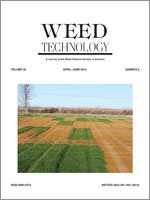Field trials were initiated in fall 2011 to determine the potential of pyroxasulfone to control acetolactate synthase (ALS) inhibitor-resistant weeds in field pea. Pyroxasulfone was applied in split-plot trials at five locations in western Canada using fall and PRE spring applications of 0 to 400 g ai ha−1. Trial locations were chosen with a range of soil organic matter content: 2.9, 4.3, 5.5, 10.5, and 10.6% at Scott, Kernen, Kinsella, Melfort, and Ellerslie, respectively. The herbicide dose required to reduce biomass by 50% (ED50) in false cleavers ranged between 53 and 395 g ha−1 at Scott and Ellerslie, respectively. Wild oat ED50s varied between 0.54 g ha−1 at Scott in the fall and 410 g ai ha−1 in the spring at Melfort. ED50s for wild oat and false cleavers varied by 7.4- and 746-fold, respectively, depending primarily on the organic matter content at the trial location. The effect of application timing was not consistent. Significant yield reductions and pea injury occurred at 150 and 100 g ha−1 and higher at Kernen and Scott, respectively. Low organic matter and high precipitation levels at these locations indicates increased herbicide activity under these conditions. Pyroxasulfone may allow control of ALS inhibitor-resistant false cleavers and wild oat; however, locations with high soil organic matter will require higher rates than those with low organic matter for similar control levels.
Nomenclature: Pyroxasulfone; false cleavers; Galium spurium L. GALSP; wild oat; Avena fatua L. AVEFA; field pea; Pisum sativum L.
En el otoño de 2011, se iniciaron estudios de campo para determinar el potencial de pyroxasulfone para el control de malezas resistentes a inhibidores de acetolactate synthase (ALS) en campos de guisante. Se aplicó pyroxasulfone en ensayos de parcelas-divididas en cinco localidades en el oeste de Canadá usando aplicaciones en el otoño y PRE en la primavera de 0 y 400 g ai ha−1. Las localidades fueron escogidas para abarcar diferentes contenidos de materia orgánica: 2.9, 4.3, 5.5, 10.5 y 10.6% en Scott, Kernen, Kinsella, Melfort, y Ellerslie, respectivamente. La dosis requerida para reducir la biomasa en 50% (ED50) de Galium spurium varió entre 53 y 395 g ha−1 en Scott y Ellerslie, respectivamente. La ED50 para Avena fatua varió entre 0.54 g ha−1 en Scott en el otoño y 410 g ha−1 en la primavera en Melfort. Las ED50 variaron para A. fatua y G. spurium entre 7.4 y 746 veces, respectivamente, dependiendo principalmente del contenido de materia orgánica en la localidad donde se realizó el experimento. El efecto del momento de aplicación no fue consistente. Reducciones significativas de rendimiento y daño en el guisante ocurrieron a dosis de 150 y 100 g ha−1 y mayores en Kernen y Scott, respectivamente. Bajos niveles de materia orgánica y altos niveles de precipitación en estas localidades indican, que bajo estas condiciones, hay una mayor actividad del herbicida. Pyroxasulfone podría permitir el control de G. spurium y A. fatua resistentes a herbicidas inhibidores de ALS. Sin embargo, en lugares con alto contenido de materia orgánica se requerirán dosis más altas que las requeridas en suelos con bajos niveles de materia orgánica para obtener un control similar.





